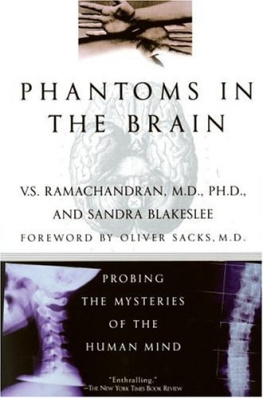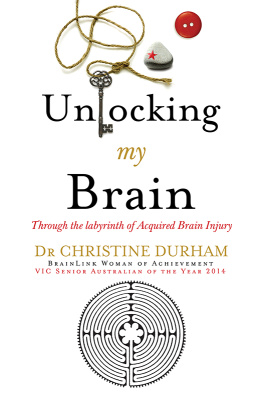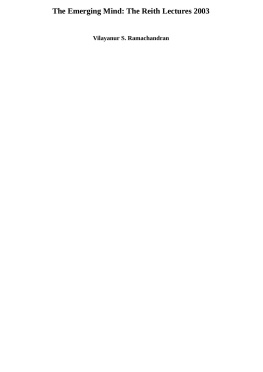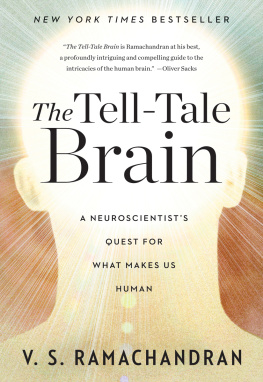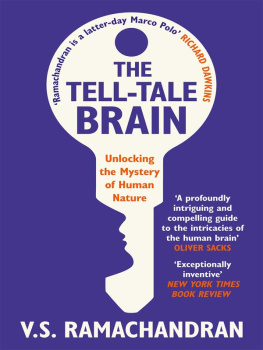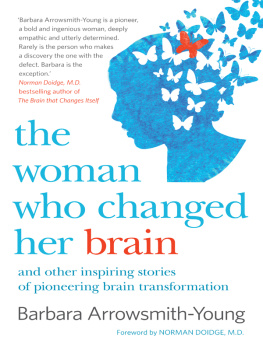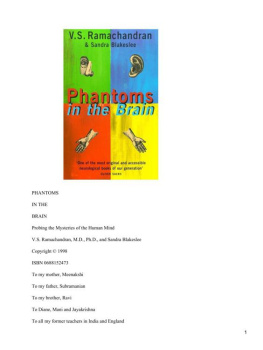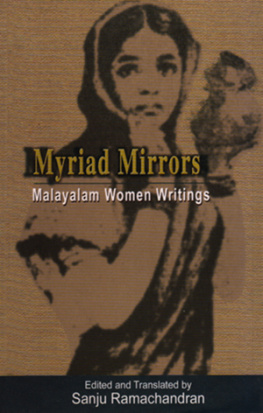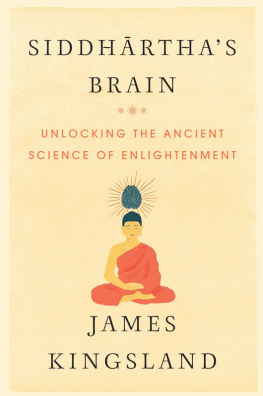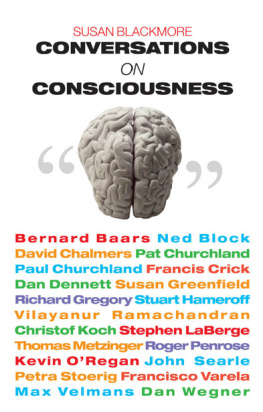V. S. Ramachandran - The Tell-Tale Brain: Unlocking the Mystery of Human Nature
Here you can read online V. S. Ramachandran - The Tell-Tale Brain: Unlocking the Mystery of Human Nature full text of the book (entire story) in english for free. Download pdf and epub, get meaning, cover and reviews about this ebook. year: 2011, publisher: Random House, genre: Religion. Description of the work, (preface) as well as reviews are available. Best literature library LitArk.com created for fans of good reading and offers a wide selection of genres:
Romance novel
Science fiction
Adventure
Detective
Science
History
Home and family
Prose
Art
Politics
Computer
Non-fiction
Religion
Business
Children
Humor
Choose a favorite category and find really read worthwhile books. Enjoy immersion in the world of imagination, feel the emotions of the characters or learn something new for yourself, make an fascinating discovery.
- Book:The Tell-Tale Brain: Unlocking the Mystery of Human Nature
- Author:
- Publisher:Random House
- Genre:
- Year:2011
- Rating:5 / 5
- Favourites:Add to favourites
- Your mark:
- 100
- 1
- 2
- 3
- 4
- 5
The Tell-Tale Brain: Unlocking the Mystery of Human Nature: summary, description and annotation
We offer to read an annotation, description, summary or preface (depends on what the author of the book "The Tell-Tale Brain: Unlocking the Mystery of Human Nature" wrote himself). If you haven't found the necessary information about the book — write in the comments, we will try to find it.
The Tell-Tale Brain: Unlocking the Mystery of Human Nature — read online for free the complete book (whole text) full work
Below is the text of the book, divided by pages. System saving the place of the last page read, allows you to conveniently read the book "The Tell-Tale Brain: Unlocking the Mystery of Human Nature" online for free, without having to search again every time where you left off. Put a bookmark, and you can go to the page where you finished reading at any time.
Font size:
Interval:
Bookmark:
About the Book
Vilayanur S. Ramachandran is Director of the Centre for the Brain at the University of California, San Diego. He obtained his MD at Stanley Medical College in Madras, India, has a PhD from Trinity College, Cambridge, and has received many honours and awards including a fellowship from All Souls College, Oxford. He lectures widely on art, visual perception and the brain, gave the 2003 BBC Reith Lectures, and is the author of the critically acclaimed Phantoms in the Brain, which was the basis for a two-part series on Channel Four. He has been called The Marco Polo of neuroscience by Richard Dawkins and the modern Paul Broca by Eric Kandel, and Newsweek magazine named him a member of The Century Club, one of the hundred most prominent people to watch in the 21st century. V. S. Ramachandran has pushed forward the frontiers of neuroscience. A brilliant neurologist known for his ability to solve some of the most perplexing riddles of his field, he can also communicate the hard science into a language everyone can understand.
Ramachandran is famous for his intuitive, Sherlock Holmes-style approach to bizarre and baffling brain disorders, from autism and synaesthesia to apotemnophilia (an obsession with self-amputation) and Capgrass syndrome (where patients who are otherwise lucid become convinced that their loved ones, and even their own reflections, are imposters). He is also the first man ever to successfully amputate a phantom limb using just a cardboard box and a mirror.
This major new work explores why the human brain is so unique and how it became so enchantingly complex. Taking us to the frontiers of neurology, Ramachandran reveals what the most extreme case studies can teach us about the brain and how it evolved, as well as offering startling new ideas about how language developed, why we like art and why we can empathise with one another. Along the way we hear stories that are by turns moving, funny, tragic, disturbing, but always informative and utterly fascinating.



This eBook is copyright material and must not be copied, reproduced, transferred, distributed, leased, licensed or publicly performed or used in any way except as specifically permitted in writing by the publishers, as allowed under the terms and conditions under which it was purchased or as strictly permitted by applicable copyright law. Any unauthorised distribution or use of this text may be a direct infringement of the authors and publishers rights and those responsible may be liable in law accordingly.
Version 1.0
Epub ISBN 9781409038115
www.randomhouse.co.uk
Published by William Heinemann 2011
2 4 6 8 10 9 7 5 3 1
Copyright V. S. Ramachandran 2011
V. S. Ramachandran has asserted his right under the Copyright, Designs and Patents Act 1988 to be identified as the author of this work
This book is sold subject to the condition that it shall not, by way of trade or otherwise, be lent, resold, hired out, or otherwise circulated without the publishers prior consent in any form of binding or cover other than that in which it is published and without a similar condition, including this condition, being imposed on the subsequent purchaser
: Illustration from Animal Architecture by Karl von Frisch and Otto von Frisch, illustrations copyright c. 1974 by Turid Holldobler, reprinted by permission of Harcourt, Inc.
First published in Great Britain in 2011 by
William Heinemann
Random House, 20 Vauxhall Bridge Road,
London SW1V 2SA
www.rbooks.co.uk
Addresses for companies within The Random House Group Limited can be found at: www.randomhouse.co.uk/offices.htm
The Random House Group Limited Reg. No. 954009
A CIP catalogue record for this book is available from the British Library
ISBN 9780434020232
CONTENTS

For my mother, V. S. Meenakshi, and
my father, V. M. Subramanian
For Jaya Krishnan, Mani, and Diane
And for my ancestral sage Bharadhwaja ,
who brought medicine down from the gods to mortals

ALSO BY
V. S. RAMACHANDRAN

A Brief Tour of Human Consciousness
Phantoms in the Brain

There is not, within the wide range of philosophical inquiry, a subject more intensely interesting to all who thirst for knowledge, than the precise nature of that important mental superiority which elevates the human being above the brute
EDWARD BLYTH
F OR THE PAST QUARTER CENTURY I HAVE HAD THE MARVELOUS privilege of being able to work in the emerging field of cognitive neuroscience. This book is a distillation of a large chunk of my lifes work, which has been to unravelstrand by elusive strandthe mysterious connections between brain, mind, and body. In the chapters ahead I recount my investigations of various aspects of our inner mental life that we are naturally curious about. How do we perceive the world? What is the so-called mind-body connection? What determines your sexual identity? What is consciousness? What goes wrong in autism? How can we account for all of those mysterious faculties that are so quintessentially human, such as art, language, metaphor, creativity, self-awareness, and even religious sensibilities? As a scientist I am driven by an intense curiosity to learn how the brain of an apean ape!managed to evolve such a godlike array of mental abilities.
My approach to these questions has been to study patients with damage or genetic quirks in different parts of their brains that produce bizarre effects on their minds or behavior. Over the years I have worked with hundreds of patients afflicted (though some feel they are blessed) with a great diversity of unusual and curious neurological disorders. For example, people who see musical tones or taste the textures of everything they touch, or the patient who experiences himself leaving his body and viewing it from above near the ceiling. In this book I describe what I have learned from these cases. Disorders like these are always baffling at first, but thanks to the magic of the scientific method we can render them comprehensible by doing the right experiments. In recounting each case I will take you through the same step-by-step reasoningoccasionally navigating the gaps with wild intuitive hunchesthat I went through in my own mind as I puzzled over how to render it explicable. Often when a clinical mystery is solved, the explanation reveals something new about how the normal, healthy brain works, and yields unexpected insights into some of our most cherished mental faculties. I hope that you, the reader, will find these journeys as interesting as I did.
Readers who have assiduously followed my whole oeuvre over the years will recognize some of the case histories that I presented in my previous books, Phantoms in the Brain and A Brief Tour of Human Consciousness . These same readers will be pleased to see that I have new things to say about even my earlier findings and observations. Brain science has advanced at an astonishing pace over the past fifteen years, lending fresh perspectives onwell, just about everything. After decades of floundering in the shadow of the hard sciences, the age of neuroscience has truly dawned, and this rapid progress has directed and enriched my own work.
Next pageFont size:
Interval:
Bookmark:
Similar books «The Tell-Tale Brain: Unlocking the Mystery of Human Nature»
Look at similar books to The Tell-Tale Brain: Unlocking the Mystery of Human Nature. We have selected literature similar in name and meaning in the hope of providing readers with more options to find new, interesting, not yet read works.
Discussion, reviews of the book The Tell-Tale Brain: Unlocking the Mystery of Human Nature and just readers' own opinions. Leave your comments, write what you think about the work, its meaning or the main characters. Specify what exactly you liked and what you didn't like, and why you think so.


